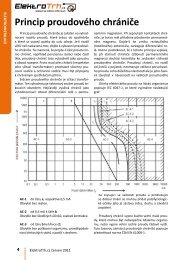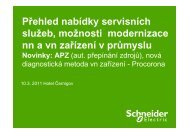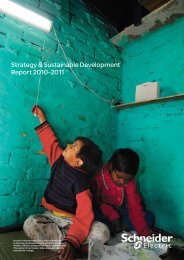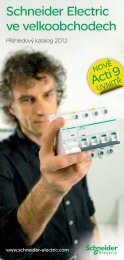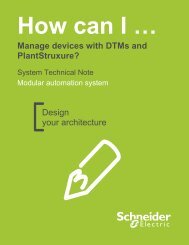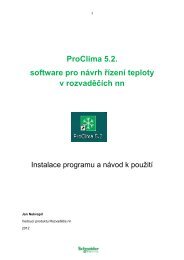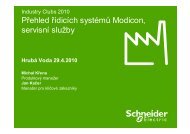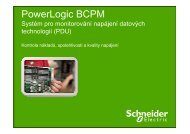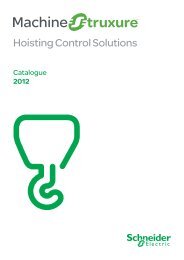2010Annual Report - Schneider Electric CZ, s.r.o.
2010Annual Report - Schneider Electric CZ, s.r.o.
2010Annual Report - Schneider Electric CZ, s.r.o.
You also want an ePaper? Increase the reach of your titles
YUMPU automatically turns print PDFs into web optimized ePapers that Google loves.
3 CORPORATE GOVERNANCE<br />
INTERNAL CONTROL AND RISK MANAGEMENT<br />
136<br />
The Department’s audit assignments go beyond the Key Internal<br />
Controls, and include an in-depth review of processes and their<br />
effectiveness, focusing on compliance and/or performance,<br />
depending on the size of the audited unit and the identifi ed risks<br />
and challenges.<br />
The internal auditors also review newly acquired units to assess their<br />
level of integration and ensure that Group rules and guidelines are<br />
properly applied.<br />
A summary overview of the department’s audits makes it possible<br />
to identify any emerging or recurring risks that require new risk<br />
management tools and methodologies or adjustments to existing<br />
resources.<br />
In 2010, Senior Management ordered unscheduled audits on<br />
emerging risks that led to the revision of certain internal procedures.<br />
In 2010, the internal auditors performed 17 audits, including:<br />
• full audits of medium-sized units;<br />
• audits of a number of risks or operating processes;<br />
• post-acquisition audits for newly acquired companies;<br />
• analyses of control self-assessments by the units;<br />
• follow-up audits to ensure recommendations are applied.<br />
5.6. Committee on Ethics and Responsibility<br />
The Committee on Ethics and Responsibility steers action in relation<br />
to the Principles of Responsibility, updates them and validates<br />
changes. It also answers employee questions that are not addressed<br />
in the companion guide to the Principles of Responsibility, or that<br />
employees’ own managers are unable to answer.<br />
(see “Sustainable development framework”, Chapter 2 § 2)<br />
5.7. Fraud Committee<br />
In 2010, the Fraud Committee formalised the policy against fraud<br />
and the process of reporting and treating fraud and suspected fraud,<br />
including changes in procedures or practices to avoid recurrence.<br />
5.8. 2010: further enhancement of the internal<br />
control system<br />
In 2010, further efforts were made to improve the identifi cation and<br />
control of general risks, to step up periodic reviews of results and<br />
performance, and to enhance auditing practices. The year was<br />
marked, for the internal control system, by the items set out above,<br />
in particular:<br />
• the work of the Committee on Responsibility and Ethics and the<br />
Fraud Committee continued (see above);<br />
• a process involving the systematic reporting and analysis of<br />
cases of fraud detected within the Group was established;<br />
• internal control self-assessment questionnaires were sent out<br />
to cover 90% of the Group’s consolidated revenue (training<br />
managers in internal control practices, defi ning and implementing<br />
remedial action plans if needed);<br />
• the process of separating management tasks in IT systems<br />
through a pilot project conducted within the bridge project was<br />
rolled out on an industrial scale.<br />
In 2011, further work will be done to strengthen the system:<br />
• entities acquired with Areva Distribution will be brought into the<br />
self-assessment process;<br />
• a dedicated software package for the management of selfassessment<br />
questionnaires and follow-up action plans will be<br />
ushered in to replace the “in-house” application used to date;<br />
• local internal audit teams in the Operating Divisions will be<br />
reinforced.<br />
6. Internal control procedures governing the production and processing<br />
of accounting and financial information<br />
In addition to:<br />
• its regulatory tasks;<br />
• its responsibility for overseeing the close of accounts across the<br />
Group;<br />
• its audits of the Group’s performances with respect to targets<br />
(see “Internal Control Organisation and Management: Finance<br />
and Control – Legal Affairs”).<br />
The Management Control and Accounting unit is tasked with<br />
overseeing:<br />
• the quality of reporting packages submitted monthly by the<br />
subsidiaries;<br />
• the results of programmed procedures;<br />
• the integrity of the consolidation system database.<br />
2010 REGISTRATION DOCUMENT SCHNEIDER ELECTRIC<br />
The Management Control and Accounting unit ensures that:<br />
• all of the subsidiaries perform a hard close at May 31 and<br />
November 30 of each year and the majority of consolidation<br />
adjustments for the period are also calculated at these dates so<br />
that the consolidated fi nancial statements can be produced 16<br />
working days after the annual or half-yearly period-end;<br />
• the scope of consolidation is determined and, in cooperation with<br />
the Legal Affairs Department, the Group’s interest and the type<br />
of control (exclusive control, joint control, signifi cant infl uence) of<br />
each subsidiary, determined on the basis of the consolidation<br />
method;<br />
• instructions are issued for the closing process, including reporting<br />
deadlines, required data and any necessary adjustments;<br />
• the Group’s consolidated fi nancial statements are analysed<br />
in detail, to understand and check the main contributions by<br />
subsidiaries, as well as the substance of transactions refl ected<br />
in the accounts;




